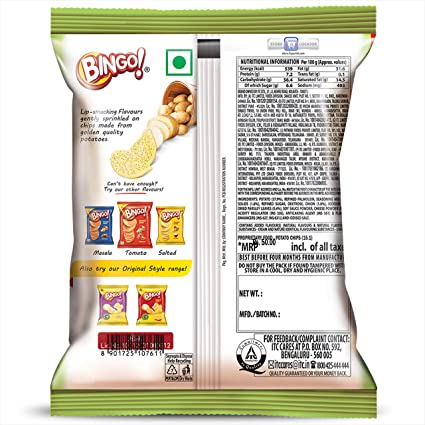An Overview Of The Legal Metrology Act, 2009 In Light Of The Latest Developments
INTRODUCTION
In India, goods which are sold or distributed by weight, measure or numbers are regulated by The Legal Metrology Act, 2009 (hereinafter referred to as “the act”). The Act was introduced with the central objective of bringing about unified standards for weights and measures in the country. It is a mandate under Section 18 of the act that pre-packaged commodities must be in standard quantities and shall provide for certain declarations as prescribed under the act. Further, the section also provides that in case a pre-packaged commodity is advertised, then such advertisements shall also declare the net quantity or number of the commodities contained in the package along with the retail price.[1]

To further the object of The Legal Metrology Act, 2009 and to regulate pre-packaged commodities, the Department of Consumer affairs has notified the Legal Metrology (Packaged Commodities) Rules, 2011(hereinafter referred to as “the rules”) which are amended from time to time. The rules safeguard the rights of consumers to be informed about the quality, quantity, standard and price of goods so as to be protected against unfair trade practices.
What are pre-packaged commodities?
The Act defines “pre-packaged commodity” as a commodity that is placed in a package of any kind, whether sealed or not, without the purchaser’s presence, so that the product contained therein has a pre-determined quantity.[2] Simply put, a pre-packaged commodity is a term used to indicate a commodity having a certain pre-determined quantity which is placed in a package to form a packaged product before the packaged product is made available for purchasing.
THE REQUIREMENT OF MANDATORY DECLARATIONS:
The 2011 Rules provides that every Manufacturer, Packer or Importer of commodities is required to obtain registration for the purpose of pre-packing or importing any commodity in the event of any sale, distribution or delivery. As per the Rules, following particulars shall mandatorily be declared on the package of pre-packaged commodities[3]:
- Name and address of the manufacturer, packer or the importer of the products.
- In the case of imported goods, the name of the country of origin, manufacture, or assembly.
- The common or generic names of the commodity contained in the package.
- In case of packages with more than one product, the name and number of each product.
- The net quantity of the commodity in terms of the standard unit of weight or measure.
- The month and year in which the commodity is manufactured.
- Maximum retail price inclusive of all taxes.
- The dimension of the commodity contained in the package where the size of the commodity is relevant.
- Name, address, email and telephone of the person to be contacted in case of consumer complaint
Images given below depict how the mandatory information must be declared on the package of a pre-packaged product:
[Image source: lense.google.com] [Image source: lense.google.com]
Principle display panel:
According to the rules, the required declarations must be made on the principal display panel of the package. Principal display panel is the surface area on the package of a product where the information as according to the declarations has to be provided for. There are two ways in which the required information can be given:
(i) all the information could be grouped together and given at one place; or
(ii) the pre-printed information could be grouped together and given in one place and on line information grouped together in other place.[4]
The Rules strictly prohibit affixing of stickers on the packages for altering or making any declarations. However, for reducing the Maximum Retail Price (MRP), a sticker with the revised lower MRP (inclusive of all taxes) may be affixed and the same shall not cover the MRP declaration made by the manufacturer or the packer on the label of the package.[5] Though, it is permissible to affix a label on imported packages for making the declarations required under these rules.[6]
For soft drink, ready to serve fruit beverages or the like, the bottle which is returnable by the consumer for being refilled, the retail sale price may be indicated either on the crown cap, or on the bottle or on both and if the retail sale price is indicated on the crown cap or the bottle, it is sufficient to indicate the retail sale price in the form of ‘MRP Rs…. /……..’.[7]
MANNER IN WHICH DECLARATION SHALL BE MADE:
The rules mandate that every declaration which is required to be made on a package under these rules shall be legible and prominent.[8] The area surrounding the quantity declaration shall be free from printed information.[9] The numerals of the retail sale price and net quantity declaration shall be printed, painted or inscribed on the package in a colour that contrasts conspicuously with the background of the label. However, where any label information is blown, formed or moulded on a glass or plastic surface such information need not be required to be presented in a contrasting colour. Even if any declaration on a package is printed either in the form of hand-writing or hand-script, such declaration shall be clear, unambiguous and legible.[10]
The particulars of the declarations required to be specified under this rule on a package shall either be in Hindi in Devnagri script or in English. Declarations can be made in any other language in addition to Hindi or English language.[11]
Along with the declarations mentioned above, additional requirements are given under the rules which varies with the type and category of goods provided inside the package. Further details regarding the manifold requirements are provided herein below:
- Declarations in case of perishable food items:
In the case of food items which are likely to decay after a certain period of time, ‘best before or use by the date, month and year’ shall be mentioned on the package of the commodity. Best before means the date until which the product will retain the qualities which has been claimed but beyond such date, the commodity may still be safe for consumption. Use by date refers to the date beyond which the product will not be safe for consumption. After this date, the product should not be marketed/ sold.[12]
[Image source: Twitter] [Image source: Lensi.google.com]
- Declarations in case of genetically modified food items:
The rules mandate that every package containing the genetically modified food shall bear at the top of its principal display panel the words “GM”.[13]
[Image source:.feralfig] [Image source:eportfolios]
- Declarations in case of cosmetics and toiletries items:
According to the rules, every package containing soap, shampoos, tooth pastes and other cosmetics and toiletries shall bear at the top of its principal display panel a red or as the case may be, brown dot for products of non-vegetarian origin and a green dot product of vegetarian origin.[14]
Depictions of green dot and red dot on product packages are given below:
[Image Source:Amazon] [Image Source: 5.imimg]
Declarations in case of wholesale packages:
The Rules mandates information regarding the name and address of the manufacturer or importer or where the manufacturer or importer is not the packer, of the packer; the identity of the commodity contained in the package; and the total number of retail package contained in such wholesale package or the net quantity in terms of standard units of weights, measures or number of the commodity contained in wholesale package to be declared on product packages.[15]
- General rules regarding declaration of quantity and advertisement of a packaged commodity:
In declaring the net quantity of the commodity contained in a package, the weight of wrappers and materials other than the commodity shall be excluded.[16] The rules mandate that only the International System of Units shall be used in furnishing the net quantity of a package.[17]
Where a commodity is likely to go no variation or negligible variation due to environmental conditions, the quantity declared on the package must be same as the quantity received by a consumer. However, when the commodity is likely to undergo significant variations, the quantity may be quailed by the words ‘when packed’.[18] No number called the dozen, score, gross, great gross or the like shall be specified or indicated on any package.[19]
The rules mandate that any advertisement mentioning the retail sale price of the pre-packaged commodity shall contain a declaration as to the net quantity or number of the commodity contained in the package. The font size of the net quantity in the advertisement shall be same as that of retail sale price.[20]
EXEMPTIONS PROVIDED UNDER THE RULES:
The mandatory requirement of above-mentioned declarations is excluded for the following items such as:
- Packages of commodities containing quantity of more than 25 kg or 25 litre cement;
- Fertiliser and agricultural farm produce sold in bags above 50 kg;
- Packaged commodities meant for industrial consumers or institutional consumers.[21]
It is further interesting to note that bidis or incense sticks and domestic liquified petroleum gas (14.2 kg or 5 kg, bottled and marketed by a public sector undertaking) are excluded from the essential of declaration as to the month and year in which the commodity is manufactured or pre-packed. Also, no declaration of retail sale prices shall be made on any package containing bidis and domesticated liquefied petroleum gas cylinder where the price is determined by the government.[22]
However, the rules do not prevent the printing of Barcode or GTIN or QR Codes or ‘e-code’ for net quantity assurance of the commodity or logos of Government schemes, such as Swatch Bharat Mission or other required declarations on the package of a product.[23]
E COMMERCE ENTITIES AND THE MANDATE OF DECLARATION:
With respect to E commerce entities the position of law is slightly different, as the rules provide that it shall display the required declarations on their website except the month and year the commodity is manufactured or packed.
Law imposes secondary liability on e-commerce entities as they are conceived as mere conduits of information. Responsibility of the correctness of declarations shall not lie with the e-commerce entity if its function is only of a facilitator of communication between the buyer and the seller; there is no involvement of the entity in initiation or selection or modification of any information related to the products provided by a seller and the entity observes due diligence while discharging its duty as an intermediary under the Information Technology Act, 2000 as well as observes the prescribed guidelines.
However, the e -commerce entity will be liable if it has conspired in the commission of an act prohibited by the rules or if the entity even after receiving actual knowledge that a product listed on their website does not conform with the mandatory requirements as per the rules, it failed in its duty to expeditiously remove or disable access to that material from its website without vitiating the evidence in any manner.[24]
RESTRICTIONS ON SALE OF EXPORT PACKAGES IN INDIA:
The rules mandate that an export package shall not be sold in India unless the manufacturer or packer has re-packed or relabelled the commodity in accordance with the provisions contained in the Rules, and where any export package is sold in India without such re-packing or re-labelling, such package shall be liable to be seized in accordance with the provisions of the Act.[25]
The concept of permissible error on package:
Certain errors regarding the required declaration on the package of a commodity are permissible under the rules. Variations which arise due to unavoidable circumstances in weighing or variations which are caused by the ordinary and customary exposure to conditions, such as, climate, transport, storage or the like that normally occur in good distribution practice after the commodity is introduced in trade or commerce; or variations due to the nature of packaging material or container are permissible.[26]
PROHIBITIONS AND PENALTIES:
Sale of packaged products on price exceeding the MRP or any alteration or smudging of retail price is strictly prohibited.[27] A fine between the range of five thousand to fifty thousand or imprisonment extending to one year is prescribed if any manufacturer, seller, distributor or importer of pre-packaged commodities do not conform with the rules mentioned.[28]
RECENT DEVELOPMENTS AND AMENDMENTS MADE UNDER THE RULES:
As notified by the Ministry of Consumer Affairs vide its notification dated March 28th 2022, The Legal Metrology (Packaged Commodities) Rules, 2011 underwent several amendments which have come into effect since October 4th 2022.
As according to the changes brought forth, when one or more packages intended for retail sale are grouped together for being sold as a retail package on promotional offers, every package of the group shall make declarations as per the requirements of the rules.[29] Further, Rule 5 which provided for specific commodities to be packed and sold in recommended standard packages was omitted from the law. Also, retail sale price of the package shall clearly indicate that it is the maximum retail price inclusive of all taxes and shall be provided in Indian currency.[30] Prior to the amendment it was stated that the package shall indicate the MRP and the price in Rupees and paise shall be rounded off to the nearest rupee or 50 paise. The amendment has also allowed that the mandatory information in elaborated form can be declared on the packages of electronic products through QR codes if not declared in the package itself.[31]
CONCLUSION:
The recent amendments sheds enhanced clarity and light over the existing provisions. It also incorporates changes which are required according to the dynamic technological changes, like providing for insertion of QR codes. Establishment of mandatory information to be declared on package of products and provision of penalty in the event of non-compliance, helps to minimise unfair trade practices and protect unwary customers from chances of exploitation.
Author: Raj Priya and Ancy Jacob, in case of any queries please contact/write back to us at support@ipandlegalfilings.com or IP & Legal Filing.
[1] The Legal Metrology Act, 2009 (1 of 2010), s. 18
[2] The Legal Metrology Act, 2009 (1 of 2010), s. 2 (l)
[3] The Legal Metrology (Packaged Commodities) Amendment (Amendment) Rules, 2022, Rule 6
[4] The Legal Metrology (Packaged Commodities) Amendment (Amendment) Rules, 2022, Rule 2 (h)
[5] The Legal Metrology (Packaged Commodities) Amendment (Amendment) Rules, 2022, Rule 6 (3)
[6] The Legal Metrology (Packaged Commodities) Amendment (Amendment) Rules, 2022, Rule 6 (9)
[7] The Legal Metrology (Packaged Commodities) Amendment (Amendment) Rules, 2022, Rule 8 (2)
[8] The Legal Metrology (Packaged Commodities) Amendment (Amendment) Rules, 2022, Rule 9 (1)
[9] The Legal Metrology (Packaged Commodities) Amendment (Amendment) Rules, 2022, Rule 8 (1)
[10] The Legal Metrology (Packaged Commodities) Amendment (Amendment) Rules, 2022, Rule 9 (1)
[11] The Legal Metrology (Packaged Commodities) Amendment (Amendment) Rules, 2022, Rule 9 (4)
[12] The Legal Metrology (Packaged Commodities) Amendment (Amendment) Rules, 2022, Rule 6 (1) (da)
[13] The Legal Metrology (Packaged Commodities) Amendment (Amendment) Rules, 2022, Rule 6 (7)
[14] The Legal Metrology (Packaged Commodities) Amendment (Amendment) Rules, 2022, Rule 6 (8)
[15] The Legal Metrology (Packaged Commodities) Amendment (Amendment) Rules, 2022, Rule 24
[16] The Legal Metrology (Packaged Commodities) Amendment (Amendment) Rules, 2022, Rule 11
[17] The Legal Metrology (Packaged Commodities) Amendment (Amendment) Rules, 2022, Rule 13(5)
[18] The Legal Metrology (Packaged Commodities) Amendment (Amendment) Rules, 2022, Rule 11
[19] The Legal Metrology (Packaged Commodities) Amendment (Amendment) Rules, 2022, Rule 13 (4)
[20] The Legal Metrology (Packaged Commodities) Amendment (Amendment) Rules, 2022, Rule 31
[21] The Legal Metrology (Packaged Commodities) Amendment (Amendment) Rules, 2022, Rule 3
[22] The Legal Metrology (Packaged Commodities) Amendment (Amendment) Rules, 2022, Rule 6(1)(g)
[23] The Legal Metrology (Packaged Commodities) Amendment (Amendment) Rules, 2022, Rule 6 (4-A)
[24] The Legal Metrology (Packaged Commodities) Amendment (Amendment) Rules, 2022, Rule 6(10)
[25] The Legal Metrology (Packaged Commodities) Amendment (Amendment) Rules, 2022, Rule 25
[26] The Legal Metrology (Packaged Commodities) Amendment (Amendment) Rules, 2022, Rule 22
[27] The Legal Metrology (Packaged Commodities) Amendment (Amendment) Rules, 2022, Rule 18
[28] The Legal Metrology Act, 2009 (1 of 2010), s. 36; The Legal Metrology (Packaged Commodities) Amendment (Amendment) Rules, 2022, Rule 32
[29] The Legal Metrology (Packaged Commodities) Amendment (Amendment) Rules, 2022, Rule 4(2)
[30] The Legal Metrology (Packaged Commodities) Amendment (Amendment) Rules, 2022, Rule 6 (1) (e)
[31] The Legal Metrology (Packaged Commodities) Amendment (Amendment) Rules, 2022, Rule 6(1) (a), Rule 6(1) (f), Rule 6(2)










